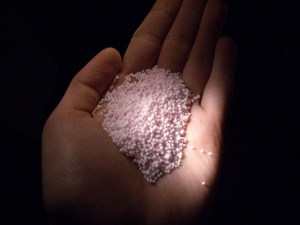By: Russ Quinn
DTN Staff Reporter
OMAHA (DTN) — Michael Carter is a fan of ammonium nitrate.
The Arcadia, Fla., citrus grower uses the fertilizer to apply nitrogen to his grove of orange trees. Most citrus growers in the Sunshine State use a blended version of ammonium nitrate, or AN, to provide a slow-release, high-content nitrogen fertilizer to their trees.

Because of ammonium nitrate’s slow release of nitrogen, it is favored in fruit and vegetable production. (Photo by Firsthuman, CC BY-SA 3.0)
“It is the most economic way to get our trees nitrogen,” Carter told DTN.
AN, once again, is in the news and not in the positive way farmers such as Carter think of it.
AN is suspected as being involved in the April 15 massive explosion of the West Fertilizer Co. in West, Texas. News reports Tuesday quoted investigators as saying a rail car load of AN, located at the West facility, did not explode but rather was blown onto its side by the blast. They haven’t ruled out that other quantities of the fertilizer may have been in the warehouse that was destroyed by the explosion.
AN was a key ingredient in the bombs used in the infamous 1995 bombing in Oklahoma City. The nitrogen source, which is also used in explosives for mining, earth moving, and similar activities, has been the cause of several international industrial accidents, claiming thousands of lives over the past 100 years.
HISTORY, HOW MUCH
AN’s history, like most commercial fertilizers, begins in the 1940s when it was used for munitions during World War II, according to a specifics sheet from the International Plant Nutrition Institute. After the war, AN became used as a commercial fertilizer in agriculture.
Direct applications of AN from June 2010 to June 2011 in the U.S. totaled 753,356 tons, according to Harry Vroomen, vice-president of economic services for The Fertilizer Institute. In addition, another 100,000 to 150,000 tons of AN were blended with other fertilizers, making total AN consumption around 900,000 tons.
Top AN consuming states are Missouri (20% of total U.S. consumption), Tennessee (14%), Alabama (10%), and Texas (8%). AN only represents approximately 2% of all directly applied nitrogen nationally.
AN production in the solid form was 2.4 million tons in 2012, TFI reported. However, about 60% of production capacity for AN is in the liquid form, he said.
Currently, AN is processed in 19 states by 12 companies with 24 production plants. TFI reported that out of those 24 production plants, only four plants are producing the solid form of AN.
The fertilizer is popular because its nitrogen is half in the nitrate form and half in the ammonium form, according to IPNI. The nitrate form moves with soil water to plant roots and is immediately available for plant uptake. The ammonium fraction is gradually converted to nitrate by soil microorganisms, IPNI reports.
FAVORED BY CITRUS GROWERS
Because of AN’s slow release of nitrogen, it is favored in fruit and vegetable production. Carter, who is the owner-operator of Bailey Branch Inc. in southwestern Florida, said he usually applies 180 pounds of blended AN on his orange trees annually.
“We will apply blended AN usually three to four times a year in the granular form, although I know other citrus growers will use liquid applications or even apply AN through irrigation,” Carter said.
Carter will blend AN with different levels of nitrogen, phosphorus and potash depending on what his soils need. His soils have a hard clay layer, which is yet another reason he uses AN to make sure the nutrient passes through this layer.
Citrus growers can use other forms of nitrogen, mainly ammonium sulfate or calcium sulfate, he said. The downside to these products is they contain a lower percentage of nitrogen, requiring higher application rates and adding to production costs.
“It wasn’t too many years ago we were spending about $100 a ton for fertilizer, now it is closer to $430 a ton,” said Carter, who has been growing oranges since 1980.
ALSO USED IN PASTURE, HAY
AN’s properties, including its resistance to nitrogen losses through volatilization when left on the soil surface, make it the nitrogen source of choice for pasture and hay production. Volatilization occurs when AN alternatives such as urea come in contact with moisture, the soil enzyme urease and crop residue. This combines to break down urea and release it as ammonia into the air, leaving less nitrogen for plants.
Gary Bates, a University of Tennessee Extension forage specialist, said AN is used as a nitrogen source for several different crops in his state. It is the recommended form of nitrogen for summer forages because it is a stable source of nitrogen compared to urea.
“If you apply urea when it is 70 to 80 degrees out and it doesn’t rain right away, the losses could be 30% or even more,” Bates told DTN. “With AN you apply it and you don’t have to worry about losing a third of it.”
In forage production, he said it is the main source of nitrogen for summer forages like sorghum sudangrass and bermudagrass, as well as stockpiling fescue grass for winter. AN would be spread on summer forages in late May while it is applied on fescue in September for growth in the winter months.
In addition, Tennessee farmers use AN in some corn and cotton production situations and in some vegetable production, mainly squash and tomatoes, he said.
Farmers producing forage for hay easily use 200 to 400 pounds of AN per acre with as much as 8 tons of hay an acre being harvested. With the cost of retail fertilizer, this represents a large input expense for hay producers, he said.
With some talk of banning AN completely, Bates said he would hate to see the fertilizer retired.
“AN serves an important agronomic purpose to Tennessee farmers,” he said.
There are alternatives to AN. Calcium ammonium nitrate is 80% AN and 20% calcium. Limestone is added to AN, which is supposed to lower the explosive capabilities of AN, he said.
Urea coated with newer urease inhibitors also allow that source to be used on summer forage without the risk of volatilization. This could be an option for Tennessee forage producers as well as calcium ammonium nitrate, Bates said.
Carter, the Florida citrus grower, said talk of banning AN does concern him as his input prices continue to rise.
“If they have to move fertilizer plants further away from population areas after this incident in Texas, this could add to our input costs as transport costs will certainly rise,” Carter said.
Source: DTN – Article





